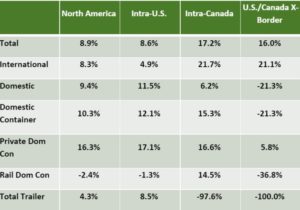Larry Gross, president and founder, Gross Transportation Consulting, and JOC analyst | Jul 12, 2021 10:20AM EDT
Ever since the precision scheduled railroading (PSR) era began there has been discussion about growth. PSR advocates asserted that while the transition to the streamlined (i.e., simpler) PSR-informed intermodal network might cost some volume in the near term, the stage was being set for a “pivot to growth.”
Once the network was right sized and operations stable and secure, the ingredients would then be in place for more highway-to-rail conversion. The Canadian railroads are held up by PSR advocates as a harbinger of growth to come. They began the transition to PSR earlier and thus are further along the conversion road. Furthermore, they have, in fact, seen impressive intermodal gains. But analysis calls this assumption into question, at least from an intermodal perspective.
Both Canadian railroads have seen impressive intermodal gains. Using data from the Association of American Railroads, comparing intermodal originations over the most recent 12-month period (June 2020 through May 2021) with the same period four years earlier, we find that Canadian intermodal volume has increased 18 percent, while US railroads have gained only 8 percent. Where is the growth coming from?
Equipment type, size, and ownership (ETSO) data from the Intermodal Association of North America (IANA) enable us to slice the data with greater precision. The table uses IANA ETSO data for the North American intermodal system as well as the major geographic markets, further divided into major equipment types. This enables us to pinpoint the areas of growth.

Overall North American intermodal activity has grown 8.9 percent during the past four years. This is very slightly above the 7.7 percent gain in US long-haul dry van/reefer truckload volume during a similar time frame and works out to a compound annual growth rate of 2.2 percent. Domestic (53-foot containers plus trailers) intermodal growth has slightly outstripped international (20-foot, 40-foot, and 45-foot ISO containers) intermodal.
Compared with North America’s 8.9 percent growth, the total gain in the intra-Canadian market of more than 17 percent looks impressive indeed. But let us dissect that growth. The bulk has been generated by the international sector, up almost 22 percent. Also in the mix is the Canada-US cross-border market, which is also controlled by the Canadian railroads. International volume was up over 21 percent. Impressive gains, but keep in mind that loaded TEU handled by the Western Canadian ports grew more than 15 percent during the same time frame. Further, import TEU gained 30 percent during that period. So certainly, a rising tide helped to lift the Canadian international intermodal boats.
But a look at the domestic sector tells quite a different story. Growth substantially trails that of North America and the US. Intra-Canadian domestic activity grew only 6 percent and the already-small domestic cross-border sector shrank by over 20 percent. If PSR is a true generator of intermodal growth, where is it?
These numbers suggest that the Canadian intermodal growth story is one more of share shift from US ports and railroads than from the highway. This is not to take anything away from the participants. These gains were the product of vision and disciplined follow-through, up to and including the creation of a new world-class container port from scratch (Prince Rupert).
But PSR is supposed to position the industry to grow the entire pie, not just change the size of the slices. International intermodal is mainly going to follow the continent’s trade trends. When imports grow faster than the overall goods economy, intermodal will benefit.
But to really grow intermodal, the only way is to convert freight from highway to rail. That will only happen when the industry puts forth a compelling combination of reliable, reasonably fast service with economic savings versus truck. PSR is supposed to deliver that combination, but the evidence thus far is not encouraging.
Contact Larry Gross at lgross@intermodalindepth.com.